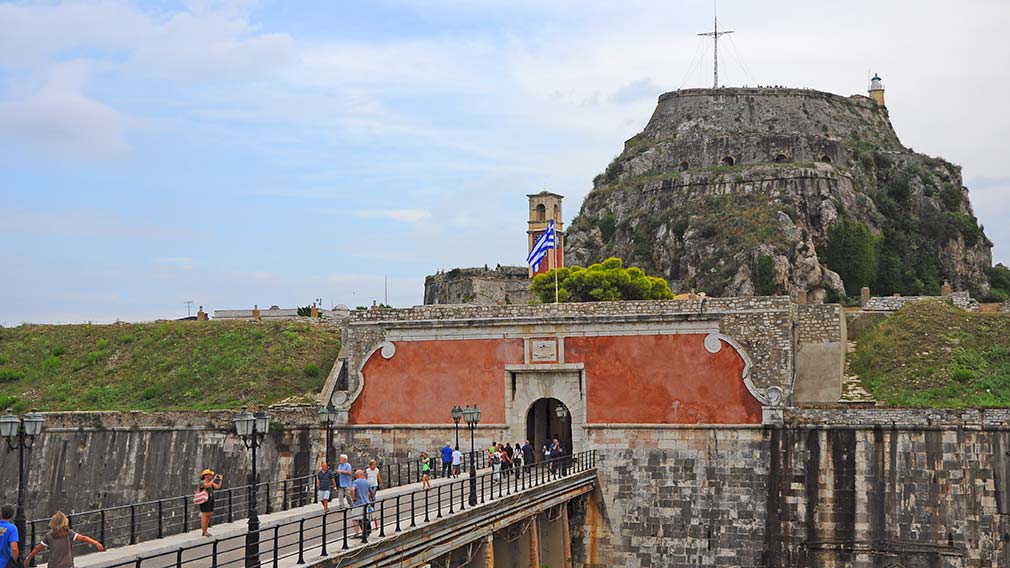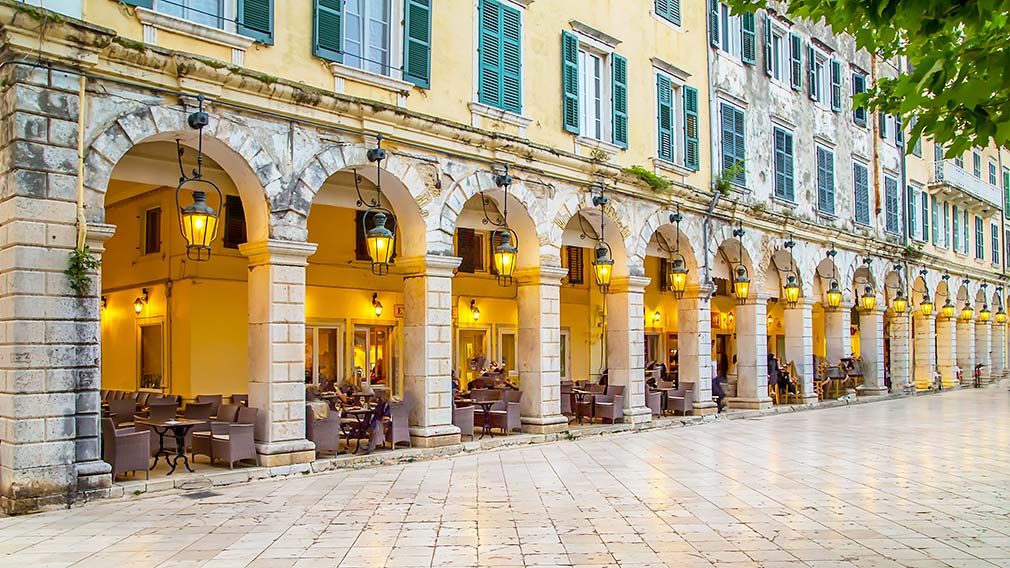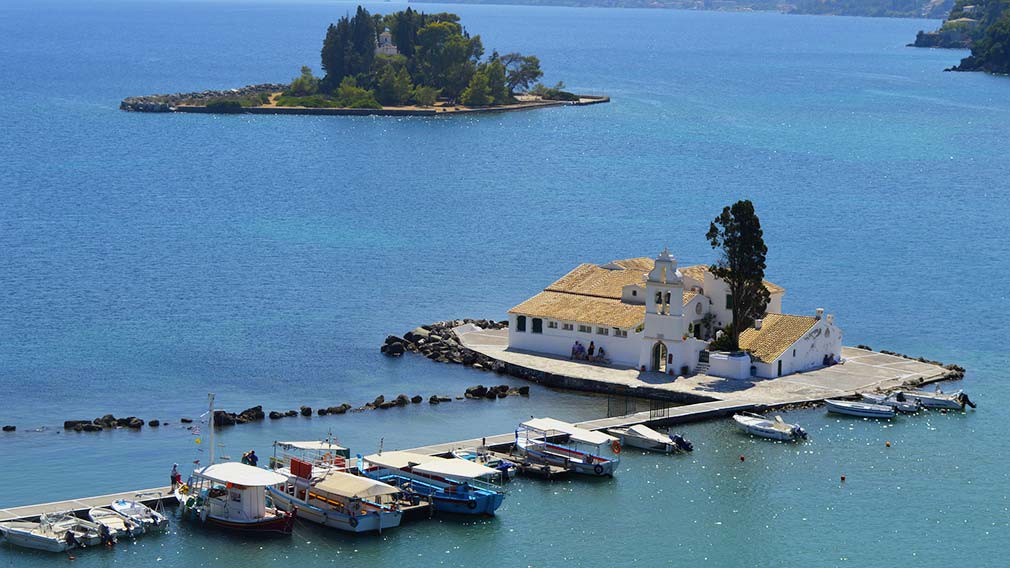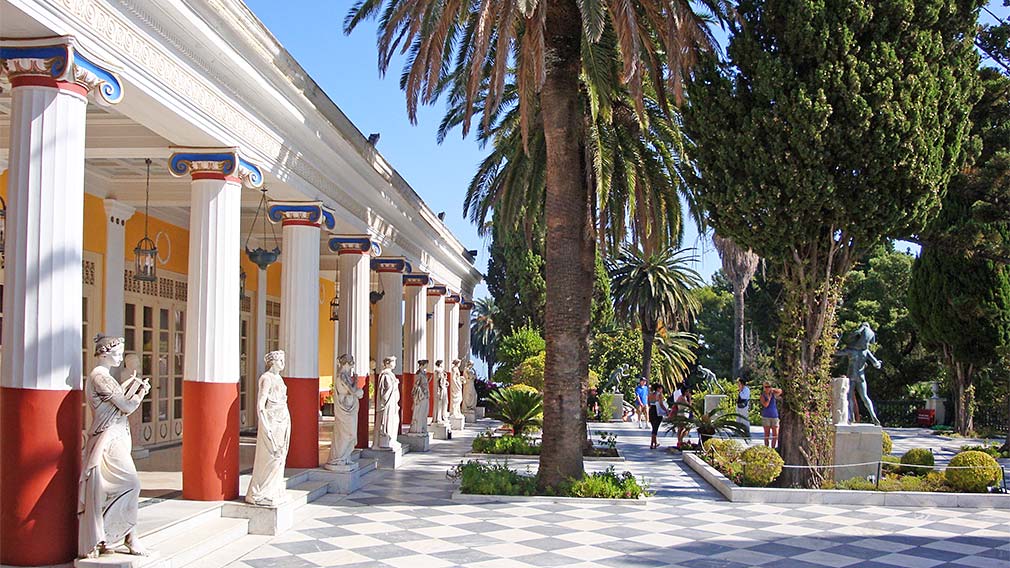Not only beaches and fun, but also historical and cultural places with great charm
A holiday in Corfu in Greece offers something to all types of tourists: sea, nature, fun and culture. In this article we guide you to discover the monuments, historical places and museums not to be missed
Corfu is certainly the most famous Greek island of the Ionian archipelago and one of the most important tourist islands in the whole Hellenic territory. Every year millions of tourists leave from all over Europe by boat or plane to spend their holidays in this fantastic destination.Unlike many other Greek tourist destinations, Corfu, in addition to the beaches, offers visitors numerous historical and cultural attractions to spend a different day or to occupy the weather on a rainy day. Below you will find, in no order of preference, what we believe to be the best 25 attractions. Which is your favourite?
1) The old town of Corfu
The historic centre of Corfu Town, the capital of the island, has been declared a UNESCO World Heritage Site and is an attraction in itself. It's wonderful to walk and get lost in the dense network of alleys, narrow streets and alleyways dotted with shops, art galleries and antique shops. Numerous historical buildings scattered throughout the city remind us that the island has been the theatre of various dominations, among the most important being the Venetian, French, English and Italian ones.
At night Corfu city has an even more bewitching atmosphere, the warm and welcoming lighting makes everything more mysterious and fascinating. One of the most beautiful places in the entire Greek territory.
2) Old Venetian fortress
The ancient Venetian fortress of Corfu welcomes with all its grandeur the travellers who reach this beautiful island by ferry. Besides being one of the symbolic monuments of Corfu, it is also one of the largest fortresses in the whole European territory. It dominates a massive promontory overlooking the sea from which you can enjoy a wonderful view of the city and the Greek coast. Its construction dates back to the XV century where there was previously a castle of Byzantine origin. Inside, besides the buildings of the ancient fortification, you can admire a small exhibition of Byzantine art, the Chapel of the Madonna del Carmine and the particular church of San Giorgio built in Doric style.

3) New Venetian fortress
This imposing and massive Venetian fortress was built between 1500 and 1600 on the western edge of the old town, but unfortunately it was largely destroyed during the Second World War. Inside there are tunnels and galleries that cannot be visited that connect it to the old fortress and other ancient buildings. Its charm is not comparable to that of the old fortress, but a visit is still worthwhile, because from its top you can enjoy a unique view of the city. Following a recent renovation, the building has become a venue for exhibitions, concerts and cultural activities of international appeal.
4) Spianada
The Spianada is a huge garden square that separates the old Venetian fortress from the rest of the historical centre of Corfu. With a length of one kilometre and a maximum width of over 200 metres, it is the second largest square in Europe. Numerous historical palaces overlook its perimeter, among which the one of San Michele and San Giorgio and the famous "Liston" the spectacular portico that rises under the elegant palaces built in French times.
5) Liston
The Liston is one of the most beautiful streets in the entire historic centre of Corfu. It is a long portico that stands at the base of a series of elegant adjacent buildings. Its construction dates back to French times and given its enormous resemblance to Rue de Rivoli in Paris it is often regarded as "a corner of Paris on Corfu". Under the portico there are restaurants and bars with an ancient and elegant flavour.

6) Saint Spyridon Church
This Orthodox church is one of the island's landmarks and is located in Corfu town in the heart of the historic centre with its tall bell tower. It was built starting from 1580 to contain the relics of the homonymous Saint still present inside the crypt. The interior has interesting decorations depicting the life of the Saint.
7) Museum of Asian art
This interesting museum is located inside the splendid Palazzo di San Michele e San Giorgio, one of the most beautiful and fascinating in the historic centre of Corfu. The opening of the museum dates back to 1927, when a local diplomat donated a vast collection of objects from Asia to the local authorities. In the following years the exhibition was gradually enriched.
The museum houses masks, weapons and armour of Japanese Samurai, statues, vases and jewellery from China and numerous other artefacts from the East.
8) Municipal art gallery
Inside the Palazzo di San Michele e San Giorgio is located this interesting resident exhibition which offers a prestigious collection of paintings by local and Greek artists from the 16th century to the present day. In addition to the permanent exhibition, numerous temporary exhibitions and cultural events are organized.
9) Dionysios Solomos Museum
Small museum dedicated to the famous Greek poet Dionysios Solomos, mainly known for writing the National Anthem. The museum is located in the historical centre of Corfu town, in the building where the poet lived most of his life. The museum exhibits furniture, manuscripts, photographs, a library containing many interesting volumes.
10) Serbian Museum of Corfu
The Serbian Museum of Corfu tells the story of the 150,000 Serbian soldiers who were exiled after the attack of 6 October 1915 by the Austro-Hungarian army during the First World War. The soldiers were hosted on the island for 3 years by the French occupiers.
The exhibition offers photographs, uniforms, flags, maps and battle plans, weapons and ammunition. The museum serves as a memorial and is supported by the Ministry of Culture and Information of the Republic of Serbia.
11) Vido Island
A small island with a diameter of 1 square kilometre which is located 1 km from the coast, just opposite the town of Corfu. It can be easily reached by small boats that depart frequently from the port of the capital. Before visiting it we recommend a stop at the Serbian museum of Corfu which tells its history. In fact, the island is mainly known because it was the place where the sick and dying Serbian soldiers exiled during the First World War were cured, but given the high mortality rate many were buried at sea. It is no coincidence that the waters around the island are also known as "the tomb of the blue sea". In the 30's the Serbs as a sign of gratitude to the Greeks erected a monument on the island of Vido that can still be visited today.
12) The banknote Museum of the Ionian Bank
The Alpha Bank banknote museum houses an interesting exhibition of some 2000 Greek banknotes printed from 1822 until the introduction of the Euro as well as various printing plates and a copy of the first treasury voucher issued. The museum is housed in an elegant building that originally housed the Ionian Bank, later merged with the Alpha Bank.
13) British Cemetery
The English Cemetery of Corfu, was created in 1814, when the island was under the British protectorate. Over the years it has been the burial place of British officials and diplomats, soldiers and residents. When the British abandoned the island, the cemetery was used for the burial of foreign families living on Corfu. The cemetery has about 500 tombs, many of them monumental, set in a tranquil naturalistic setting.
14) The theater of San Giacomo
The Noble Theatre of St. James is the first modern theatre built in Greece. Its construction began in 1663, but only in 1720 was it destined for theatrical use and soon became the national centre of Greek opera for over a century and a half. It stands in the historical centre in front of the splendid setting offered by the square in front of it.
15) Vlacherna Monastery and Pontikonissi Island
Vlacherna Monastery stands on the small islet of Pontikonissi (meaning mouse island) which is connected to the southern part of the Kanoni peninsula by a narrow concrete footbridge. It is one of the symbolic attractions of the island of Corfu which is generally immortalised by tourists from the top of the promontory above.

16) Mon Repos Villa
A few steps from the beach of the same name stands this pretty neoclassical villa built in 1828 by the United States High Commissioner of the Ionian Islands Frederick Adam. In 1863 Empress Sissi stayed there and fell so in love with Corfu that she built her summer residence there, the Achilleion Palace, whose architectural style not surprisingly recalls Villa Mon Repos. Since 2001 the villa has opened its doors to the public and is home to an archaeological museum.
17) Paleopolis, the ancient Corfù
4 km south of the capital, on the Kanoni peninsula, lies Paleopolis, the archaeological site of the ancient city of Corfu founded in the 8th century BC by the Doric Greeks of Corinth. The ancient city was an important commercial hub touched by numerous boats that docked in the port originally located between the two Venetian fortresses. Access to the archaeological area is free and with a short walk you can see the ancient walls, the remains of a temple and other buildings.
18) Achilleion Palace
The Achilleion Palace is a neoclassical style building commissioned as a summer residence by Empress Elisabeth of Austria, better known under the pseudonym Sissi. After the premature death of the princess, the palace was purchased by the German Emperor William II of Germany.
The palace was abandoned and fell into a state of decay during the First and Second World War. Only in modern times, after years of restoration work, has the palace been restored to its former glory and opened to the public.
The Achilleion Palace is located on a hill 10 km south of the capital and is easily accessible by both private and public transport. It is appreciated for the beauty of its interior, but also for its well-kept gardens.

19) Angelokastro Fortress
The ruins of the ancient fortress of Angelokastro bear witness to the Byzantine era of Corfu. This imposing fortress is located on a steep hill overlooking the sea at a height of 300 metres. Angelokastro can be easily reached by your own means of transport, but to access the castle you need to take a long, steep flight of steps. The effort is then rewarded by an incredible view of the Ionian Sea.
20) Paleokastritsa Monastery
This monastery, accessible via a small road from the bay of Agios Spyridon, is located on the top of a small promontory overlooking the sea. Its foundation dates back to 1228, but most of the buildings currently present date back to the 18th century. Thanks to its location it enjoys a breathtaking view of the sea. Walking inside you can enjoy a typical Greek atmosphere with a quiet atmosphere, gardens with flowers and aromatic herbs and a small museum with sacred Orthodox icons. There is also a shop where you can buy typical products, oil as well as the traditional local liqueur "kumquat".

21) Palies old Sinies
This old abandoned village lies a short distance from the summit of Mount Pantokrator. It was built in the 17th century, in an inaccessible but extremely panoramic position, as a defence against pirate raids. In the 60's it was definitely abandoned and its inhabitants moved to the nearby Kassiopi. Today the ruins of the houses and a couple of churches with interesting decorations remain. This destination is mainly reached by trekking lovers. As an alternative it is possible to take part in organized excursions on site.
22) Kassiopi Castle
The ruins of the castle of Kassiopi dominate the bay of the same name from above. The history of the fortress is very troubled as it was destroyed several times and then rebuilt under various dominations. The present appearance is mainly due to the Venetians who rebuilt it in the 15th century.
To reach it you can park in the centre of the village. The access is free and you can take a nice walk along the whole ring of walls that measures more than 1 kilometre.
23) Acharavi Folklore Museum
A permanent exhibition of folkloric objects inaugurated in 2008 and covering an area of over 1000 square metres. The museum has a rich exhibition of photographic material, books, documents, local costumes, agricultural equipment, a traditional oil mill, and other domestic and religious environments dating back to 1800. The collection is personally curated by the owner.
24) Venetian Arsenal
8 km north of the capital, in the tourist resort of Gouvia, there are the ruins of the ancient Venetian arsenal. The site is in a state of abandonment, but the external structure of the building is still intact and with a little imagination it is possible to reconstruct what was an important Venetian building site until 1798.
25) Kapodistrias Museum
This museum is located in Evropouli, inside "Koukouritsa", the family country house of the first head of state of independent Greece Ioannis Kapodistrias. The exhibition displays personal objects, books, maps, works of art, furniture and household appliances that belonged to the great Greek diplomat.








